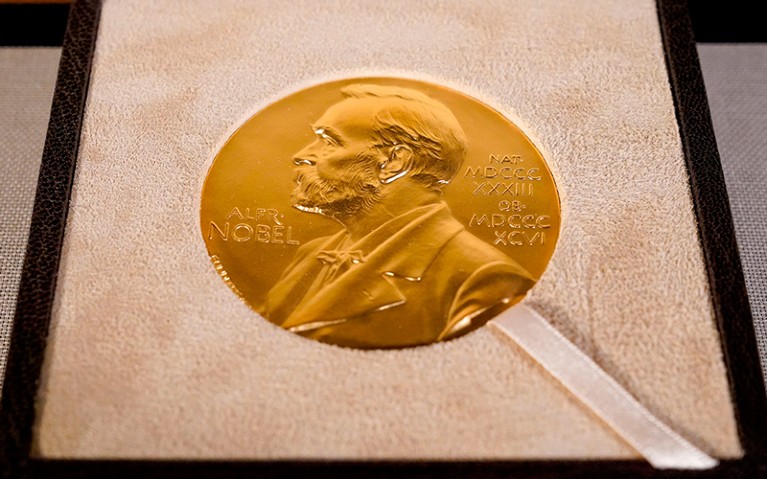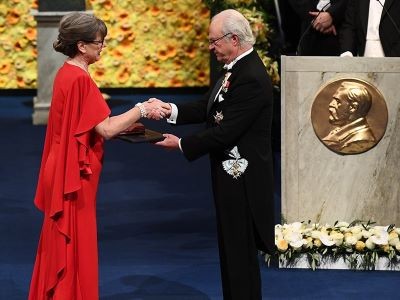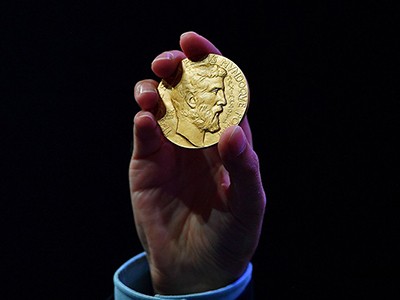
The organizers of the Nobel prizes should consider publishing aggregate data on the diversity of nominators and nominees for prizes.Credit: Mary Altaffer/AFP/Getty
Prizes boost careers and create role models. But some of the most prestigious awards are also among those with the most secretive selection processes — and that fuels the under-representation of women and people from minority groups among winners.
At its annual general assembly in Vienna last month, the European Geosciences Union (EGU) did something unusual. The chair of its awards committee, Thomas Blunier, presented a breakdown, by gender, of prize nominees and nominators since 2014. The data were revealing. Although women make up 37% of the society’s members, they made just 20% of nominations — suggesting that women are less likely to nominate than men. The data also showed that people tend to favour their own gender when making nominations — with men most likely to nominate other men.
This is clearly a problem, but awareness of the situation opens the door to fixing it. Although women are still under-represented in EGU nominations, their share of awards is now approaching their representation among EGU members, thanks to corrective measures taken by the organization’s awards committee. Sadly, however, the EGU is among the outliers — most scientific societies do not make nomination data public. They should consider doing so, because understanding patterns in nominations and nominees is integral to determining why members of groups that are marginalized in science remain under-represented among prizewinners.
Women more likely to win awards that are not named after men
Systemic barriers mean that women and people of colour, and especially women of colour, are under-represented in science in high-income nations. But this alone doesn’t suffice as an explanation for award-givers, because even when the imbalance is taken into account, women remain under-represented in prizes. According to an analysis of 141 top prizes awarded over the period from 2001 to 2020, the proportion given to women fell short of the proportion of female professors in several fields1.
The situation could well be even worse for minority genders and people of colour, but the data needed to assess this are rarely collected. The authors of an unpublished analysis of almost 9,000 winners of science prizes dating back to the eighteenth century (presented at this year’s EGU meeting) managed to identify just one woman of colour.
That said, some efforts are under way to make prizes fairer. In mathematics, for example, the International Mathematical Union, which awards the Fields Medal, has introduced guidelines to make nominators and award-committee members aware of unconscious bias. Many prize nomination forms now include statements encouraging nominators to consider diversity, and the committees that award Nobel prizes have told Nature that they are attempting to increase diversity in nominees and that the proportion of women nominated is rising. No Black person has won a natural-science prize in the awards’ 121-year history, and just 22 women have done so.
However, neither the organizers of the Fields Medal nor the organizers of the Nobel prizes publish up-to-date aggregate data on nominators or nominees. Similarly, these data are not published for awards and prizes given by Nature. We are taking measures to improve diversity, and, in future, will publish aggregate data on how applications break down by region and by gender.
The necessity of data
Nobel committee members revealed to Science last year that women made up just 7–8% of 2021 chemistry nominees2, although this, they said, was double the figure in 2018. The EGU’s example shows the necessity of such data to understanding where imbalances lie and correcting them. Prize-givers, including Nature, should find ways to collect and publish nomination data, in particular information on race, ethnicity and country of origin; Blunier noted that the EGU does not yet record these data.
Mathematics prizes have a gender problem — can it be fixed?
Prize-givers also need to widen their nomination pools. In 2019, Nature suggested that award organizers might cast their nets wider when seeking nominations3 by approaching networks that include academies of science in low- and middle-income countries, such as the International Science Council and the World Academy of Sciences. This is still not happening on the scale that it needs to. Of the three major prize-awarding organizations approached by Nature, only the Norwegian Academy of Science and Letters, which is responsible for the Kavli prizes and the Abel Prize, does so; it has done this since at least 2018. Members of the committees awarding Nobel prizes in physics, chemistry and economics say that invitations are global, going each year to faculty members at around 200 of 1,600 universities, chosen on a rotating basis. However, no information is released on their geographical distribution.
Universities can also play a part, particularly in boosting diversity in awards for which nominations are open, rather than invitation-only. Institutions can encourage a wider range of staff to submit nominations by training them in how to do it successfully, helping them with the administrative burden and encouraging them to put forward colleagues from under-represented groups.
Sadly, these measures will not make science prizes match global diversity, at least not straight away. Many prizes are based on work carried out decades ago, when the barriers to entering science were even higher than they are today for people from under-represented groups and countries. Excellent science and scientists exist everywhere. At the very least, professional societies must ensure that their nomination pools are representative of their communities. Greater transparency and a wider, more-diverse pool of nominees increases the chance of awards rewarding excellence, rather than amplifying existing networks of prestige.

 Women more likely to win awards that are not named after men
Women more likely to win awards that are not named after men
 Mathematics prizes have a gender problem — can it be fixed?
Mathematics prizes have a gender problem — can it be fixed?
 Boosting inclusivity in the Nobels
Boosting inclusivity in the Nobels
 ‘More women are being nominated’: Nobel academy head discusses diversity
‘More women are being nominated’: Nobel academy head discusses diversity






